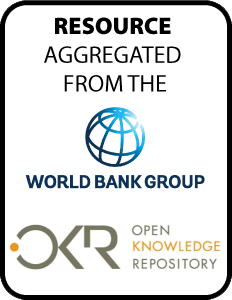The World Bank is a vital source of financial and technical assistance to developing countries around the world. We are not a bank in the ordinary sense but a unique partnership to reduce poverty and support development. The World Bank Group has two ambitious goals: End extreme poverty within a generation and boost shared prosperity.
- To end extreme poverty, the Bank's goal is to decrease the percentage of people living on less than $1.25 a day to no more than 3% by 2030.
- To promote shared prosperity, the goal is to promote income growth of the bottom 40% of the population in each country.
The World Bank Group comprises five institutions managed by their member countries.
The World Bank Group and Land: Working to protect the rights of existing land users and to help secure benefits for smallholder farmers
The World Bank (IBRD and IDA) interacts primarily with governments to increase agricultural productivity, strengthen land tenure policies and improve land governance. More than 90% of the World Bank’s agriculture portfolio focuses on the productivity and access to markets by small holder farmers. Ten percent of our projects focus on the governance of land tenure.
Similarly, investments by the International Finance Corporation (IFC), the World Bank Group’s private sector arm, including those in larger scale enterprises, overwhelmingly support smallholder farmers through improved access to finance, inputs and markets, and as direct suppliers. IFC invests in environmentally and socially sustainable private enterprises in all parts of the value chain (inputs such as irrigation and fertilizers, primary production, processing, transport and storage, traders, and risk management facilities including weather/crop insurance, warehouse financing, etc
For more information, visit the World Bank Group and land and food security (https://www.worldbank.org/en/topic/agriculture/brief/land-and-food-security1
Resources
Displaying 4456 - 4460 of 4907Distributional Implications of Climate Change in India
Global warming is expected to heavily
impact agriculture, the dominant source of livelihood for
the world's poor. Yet, little is known about the
distributional implications of climate change at the
sub-national level. Using a simple comparative statics
framework, this paper analyzes how changes in the prices of
land, labor, and food induced by modest temperature
increases over the next three decades will affect
Reducing Inequality for Shared
Growth in China : Strategy and Policy Options for Guangdong Province
This overview summarizes the key
findings of the eight chapters and one policy note. It is
organized as follows. The first section provides a
background of Guangdong, while the second describes the
current situation of inequality in the province. Next is a
discussion of the potential impacts of the transfer of
industrial activities ('industrial transfer') in
mitigating regional disparity, followed by the
Migration, Remittances and Forests : Disentangling the Impact of Population and Economic Growth on Forests
International migration has increased
rapidly in recent decades and this has been accompanied by a
remarkable increase in transfers made by migrants to their
home countries. This paper investigates the effect of the
rural economic growth brought about by migration and
remittances on Nepal's Himalayan forests. The authors
assemble a unique village-panel dataset combining remote
sensing data on land use and forest cover change with data
Zambia - Commercial Value Chains in Zambian Agriculture : Do Smallholders Benefit?
Agriculture and agroprocessing are
important in Zambia's economy, representing more than
40 percent of gross domestic product (GDP) and contributing
about 12 percent of national export earnings. Agriculture
employs some 67 percent of the labor force and supplies raw
materials to agricultural industries, which account for some
84 percent of manufacturing value-added in the country.
Smallholder agriculture dominates the rural economy. It
Assessment of the Impacts of Climate Change on Mountain Hydrology : Development of a Methodology through a Case Study in the Andes of Peru
The objective of study of the impacts of
climate change on mountain hydrology is to develop a
methodology to assess the net impacts of climate change on
the hydrological response in mountainous regions. This is
done through a case study in the Peruvian Andes. There are
few examples of predictions of the impact of climate change
on resource availability and even fewer examples of the
applications of such predictions to planning for sustainable






